by Andrew Kell | Sep 13, 2021 | PSC Priorities, Public Service Commission, Renewables, Solar, Utilities
In a stunning policy reversal, Madison Gas and Electric (MGE) submitted a proposal to lower monthly charges and raise energy rates for its residential electric customers. Filed on September 3rd, MGE’s rate application is strongly backed by customer groups and clean energy organizations, including RENEW Wisconsin.
MGE’s filing is the product of negotiations over the summer with RENEW and other parties intervening in the case. If approved as is by the Public Service Commission (PSC), the agreement will pare the fixed charge for residential electric service from $19 per month today to $17 per month in 2022 and $15 per month in 2023. At the same time, energy rates will rise to offset the proposed reduction in the fixed charge.
The monthly fixed charge is the minimum amount assessed on residential customers for electric service. These charges do not vary with energy consumption levels. Hiking fixed charges invariably depresses the volumetric rate assessed to energy consumption, penalizing customers who use relatively little electricity and those who supply themselves with solar power produced onsite. Alternatively, lowering fixed charges and raising energy rates should achieve the opposite result by sending a stronger price signal to incentivize customer investments in energy efficiency and onsite solar.
“Low-income customers, solar customers, and customers who have invested in energy efficiency to reduce energy bills will benefit from this shift,” said Heather Allen, Executive Director for RENEW Wisconsin. “Overall, MGE customers will benefit because reduced energy demand helps limit the need for additional generation capacity. This is a win-win.”
The settlement avoids a contested case hearing in which Citizens Utility Board (CUB) and RENEW had been planning to submit testimony demonstrating that the $19 per month charge was excessive, especially in an urban service territory where the majority of electric customers are renters living in multifamily dwellings.
The MGE settlement follows a similar one struck with Xcel’s Wisconsin utility several months ago. Under the terms of that settlement agreement, which RENEW, CUB and other organizations signed onto, Xcel agreed to lower its fixed charge for residential electric service from $17 per month to $16 per month in 2022 and $15 per month in 2023. As with MGE, Xcel’s energy rates will also increase.
Other positive outcomes of the settlement include MGE’s support for a low-income thermostat pilot program, exploration of further innovative ways to help low-income customers achieve lower energy bills, and MGE’s increased support for smart thermostats and technologies, such as controlled water heaters, heat pumps, and battery electric storage in future filings.
The PSC is now accepting public comments on the MGE rate case. If you’d like to support the settlement agreement, please communicate your thoughts to the PSC via this public comment webpage specific to this case. For more information on the MGE rate case, see the Wisconsin State Journal article here.
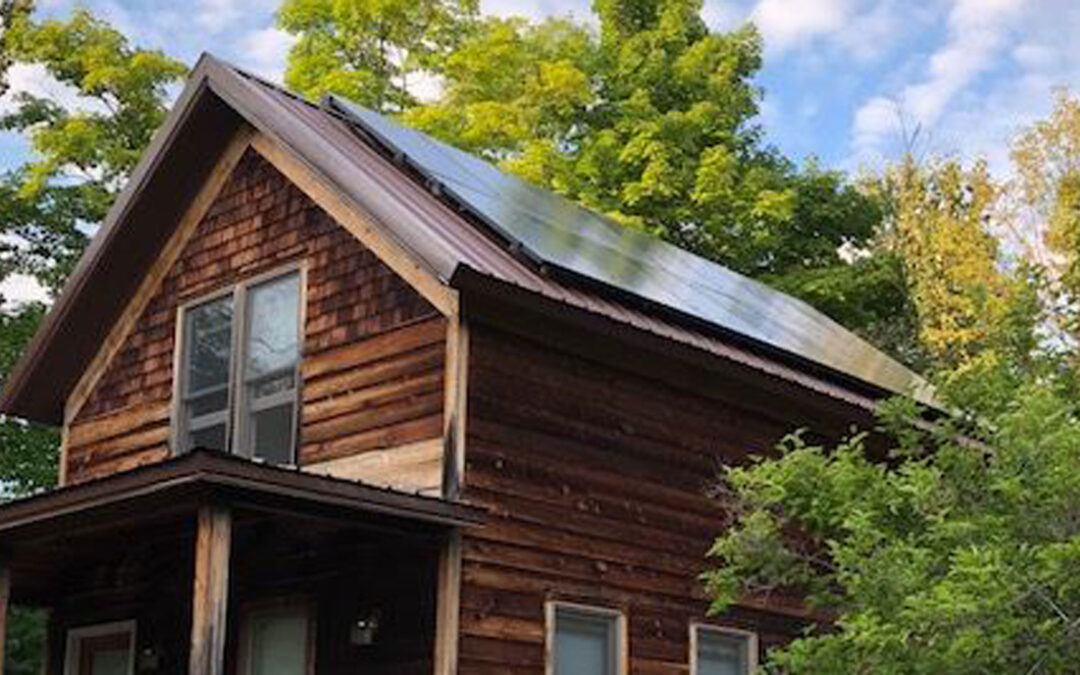
by Andrew Kell | Jul 28, 2021 | Focus on Energy, Policy, PSC Priorities, Public Service Commission
On June 29, 2021, RENEW Wisconsin hosted a webinar titled “Focus on Energy: Economic Impact in Wisconsin.” Dan York from American Council for an Energy Efficient Economy (ACEEE), Scott Blankman from Clean Wisconsin, and Maddie Wazowicz from Midwest Energy Efficiency Alliance (MEEA) provided an overview of the Focus on Energy program. In particular, Wazowicz provided pre-publication results of an upcoming Synapse Energy Economics report analyzing utility bill savings and associated efficiency of business and utility operations that would result from an increase in Focus on Energy’s annual funding.
In his introductory remarks, ACEEE’s York noted that “An analysis conducted a few years ago by the Lawrence Berkeley National Lab found that Focus on Energy was the most cost-effective program serving utility customers in the U.S.” Dan went on to say that according to ACEEE’s own state efficiency scorecard analysis, “while other states have increased their investments and associated spending for customer energy efficiency programs, such funding in Wisconsin has been largely static, locked in by the legislation that created Focus on Energy.” MEEA’s Wazowicz compared Midwestern states’ energy efficiency investments and discussed what an increase of the Focus on Energy budget could mean for Wisconsin.
To understand what additional benefits could be realized from expanding the Focus on Energy program, we can look at results from the upcoming Synapse report. The figure below uses information from a slide presented by Maddie Wazowicz at the webinar and represents pre-publication results from the Synapse study. It shows that doubling the Focus on Energy budget would translate to $20.7 million in annual utility bill savings for Wisconsin utility customers. Of that, $16.95 million in yearly utility bill savings would be realized by Wisconsin businesses if the Focus on Energy budget were doubled! This is what Wisconsin customers would save on top of savings occurring at current Focus on Energy investment levels.
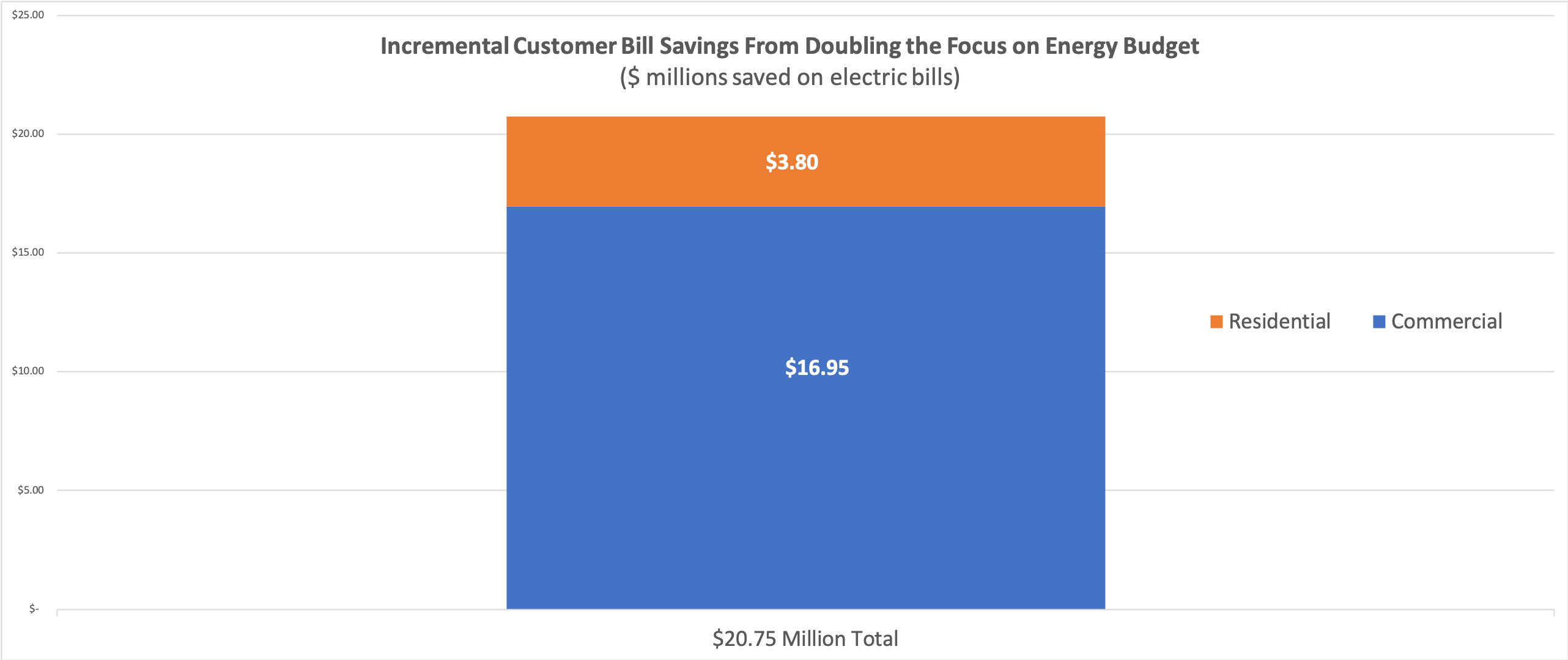
The August Synapse report details avoided utility costs, job creation, economic investment, and reduced air emissions associated with an increase in the Focus on Energy budget. Overall, the report finds that if Wisconsin doubled the Focus on Energy budget the state would receive $340 million dollars in net benefits over one year or $3.4 billion over ten years. Investing in Focus on Energy means a more clean and efficient Wisconsin economy for everyone!
The webinar then transitioned to a discussion of direct economic impacts for Wisconsin business. York moderated a panel of Wisconsin business representatives, who described their experience with the program’s energy efficiency and renewable energy incentives. The panel included Sean Hyland from American Family Insurance, Charles McGinnis from Johnson Controls, Benjamin Reynolds from Reynolds Transfer and Storage, and Tim Ulrich from Cree Lighting.
One of the hot topics of the business panel’s discussion related to data management combined with energy efficiency measures and occupancy sensors. Johnson Control’s McGinnis said that the objective of these combined technologies is to “reduce the amount of energy consumption, for the appropriate amount of occupancy, so that you can optimize the size of renewable energy application to produce green electricity.” Panelists discussed their experience with sustainability programs and performance-based metrics. In combination with his experience with the Focus on Energy program, Benjamin Reynolds described his experience with the Wisconsin Sustainable Business Council and its Green Masters Program. According to Reynolds, the Green Masters Program “is aimed at helping small-to-medium-sized businesses implement sustainability, and figure out ways to improve in energy efficiency, but also improve in waste and other performance metrics.”
Focus on Energy Impact in Wisconsin
This webinar was prompted by calls by supporters to increase funding for Focus on Energy. A RENEW blog post, penned by Michael Vickerman in October of 2020, detailed success stories and energy savings benefits realized by several Wisconsin breweries, such as Capital Brewery in Middleton, WI. That blog post referenced findings of numerous third-party evaluator annual reports on the program. These reports have found that for every dollar invested in Focus on Energy, Wisconsin receives $4 to $5 in economic and environmental benefits. That cost-to-benefit ratio represents a considerable success, as well as a huge opportunity for expansion!
The RENEW blog post also highlighted a recent review of the program by Chair Rebecca Valcq of the Public Service Commission and her request that Governor Evers propose doubling the Focus on Energy budget. Chair Valcq also recently published an op-ed in WISPOLITICS, an online journal, highlighting the economic benefits of Focus on Energy and why an increased investment is needed.
Focus on Energy is currently funded by utilities at about $95 million per year, and funding level changes can only be done through legislation. The Governor followed up on calls to increase Focus on Energy funding by doing just that with his proposed 2021-2023 budget, which RENEW highlighted in a blog post about public listening sessions earlier this year.
This past spring, legislators decided to omit all Governor Evers’ clean energy provisions from its own proposed budget, which unfortunately meant leaving an important economic growth opportunity on the cutting room floor after Governor Evers signed the state budget earlier this July.
Since its inception in 1999, Focus on Energy has fueled a more energy-efficient economy in Wisconsin. The program was created with bipartisan support and can help grow the economy once again with increased funding. Since doubling the Focus on Energy funding was not part of the state budget this year, legislators on both sides of the aisle can prioritize supporting a stand-alone piece of legislation. A clean, growing economy should be something we can all get behind!
For more information, contact Andrew Kell, RENEW Wisconsin’s Policy Analyst, andrew@renewwisconsin.org.
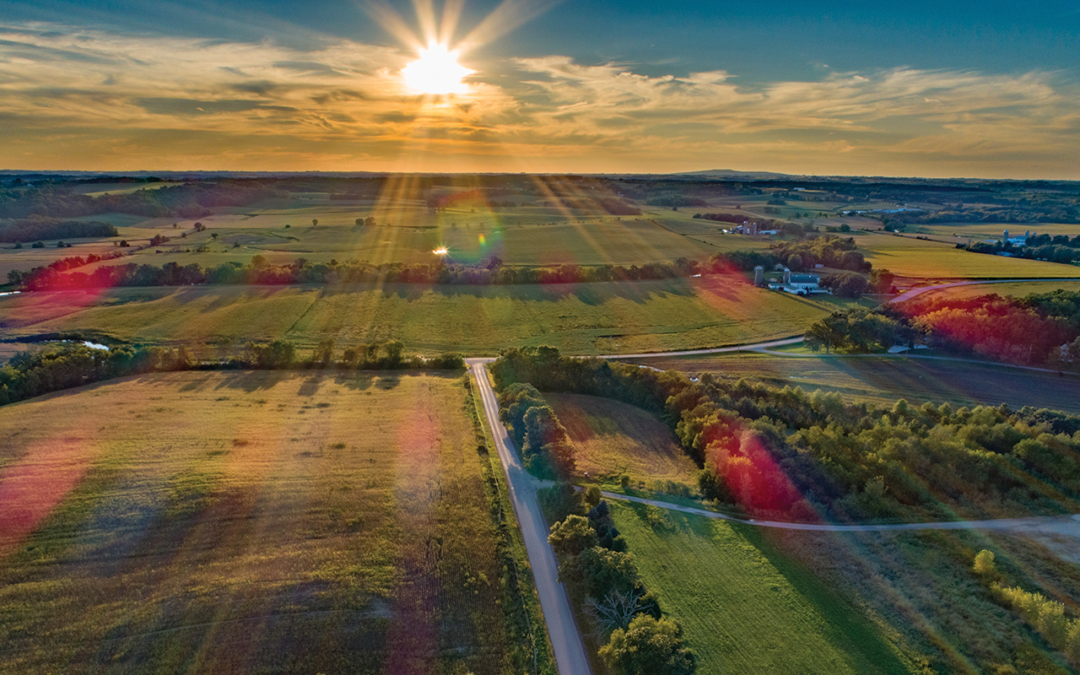
by Heather Allen | Jun 22, 2021 | Action Alert, Advocacy, Energy Storage, PSC Priorities, Public Service Commission, Solar, Utility Scale
The proposed Koshkonong Solar Energy Center would be located in southeast Dane County upstream of the Rock River. The centerpiece would be a 300-megawatt solar power generation facility anticipated to begin producing energy in 2024. Koshkonong Solar will also include a 165-megawatt battery storage component to help bolster grid reliability.
As Wisconsin continues to retire coal-fired power plants it is vital to replace those fossil fuel electricity generators with emission-free renewable energy. For example, the Columbia Energy Center, located just south of Portage, is now slated for a 2024 retirement.
Koshkonong Solar Energy Center needs vocal public support to get approved and help shift Wisconsin to clean energy. Voice your support for local solar energy by submitting a short comment today to the Public Service Commission (PSC) of Wisconsin.
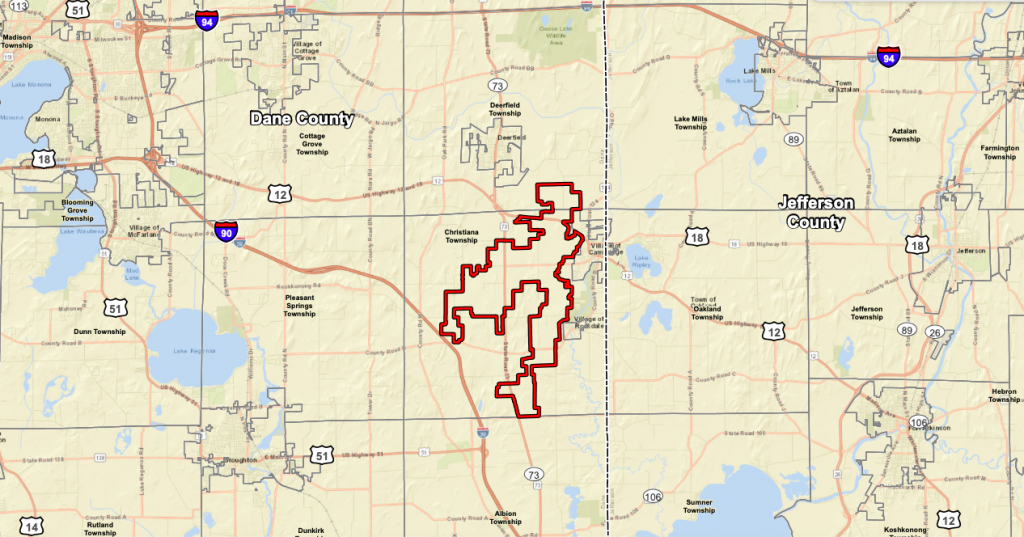
Project to be located in southeast Dane County
Koshkonong Solar would advance the clean energy goals of Dane County, its local municipalities, and residents, and the State of Wisconsin. Koshkonong Solar will generate enough emissions-free electricity to power 60,000 average American homes or just about ¼ of the 240,000 households in Dane County. The project also represents exactly ¼ of the amount of solar capacity Dane County called for in its Climate Action Plan. This single project would also bring an estimated $200 million of investment including lease payments to local landowners and new revenue streams to local governments. Local governments in the project area will receive $1.2 million per year for the life of the project based on Wisconsin’s utility aid fund formula.
The developer for this project is Invenergy, which has successfully permitted other large solar farms in Wisconsin (Badger Hollow, Paris). Koshkonong, like Invenergy’s other projects, is slated to be acquired by Wisconsin utilities, including Madison Gas and Electric.
Air Quality and Carbon Emission Reduction Benefits
Koshkonong Solar will reduce CO2 emissions by between 15 and 20 million tons over its 30-year life, along with reductions in other forms of air pollution such as 12,000 tons of nitrogen oxides (NOx), 12,000 tons of sulfur dioxide (SO2), and 804 tons of particulate matter (PM2.5).
Click here for the Koshkonong Emissions Analysis.
The emissions reductions from the estimated 600,000 megawatt-hours of energy production for the project are equivalent to the carbon sequestered by 7 million tree seedlings grown for 10 years, or the avoided CO2 emissions from 2,345 railcars worth of coal burned. See other comparisons at the EPA greenhouse gas equivalency calculator.
Soil Retention and Water Quality Benefits
Koshkonong Solar will establish deep-rooted prairie vegetation amidst the arrays. This type of vegetation will increase infiltration of the site compared with current agricultural usage by (+2.2%), reduce stormwater runoff (-60% for a 1-year 24-hour rainfall event), nitrogen outflow (-48%), phosphorus outflow (-53%), and Total Suspended Solids outflow (-87%).
These upstream water quality improvements would have a positive impact on downstream environments, and yield material benefits for watershed ecosystems, human health, and recreation. Furthermore, the prairie vegetation will help turn atmospheric carbon into organic carbon, which will be deposited and build up the soil for future agriculture. Koshkonong Solar, like other solar farms, can be returned to agricultural use after the project is completed and equipment is removed, see our solar farm FAQ to learn more.
The Public Service Commission of Wisconsin is currently reviewing the project. We are asking supporters of clean energy, conservation, and climate action to submit comments sharing their support for the project. Your support would be greatly appreciated. Your voice is crucial to move the project forward and advance the clean energy transition in Wisconsin.
Submitting a message of support is easy, simply click on the link below, fill out the form, and click ‘file’. The last day to submit letters of support is July 3rd.
Click here to submit a comment in support of Koshkonong Solar!
Weighing in today will have a tremendous impact on Wisconsin’s ability to transition to clean emission-free renewable energy! Your voice matters!
Interested in learning more?
Find answers to frequently asked questions about solar farms here.
How much agricultural land would it take to power our state with solar energy? RENEW has calculated that it would take less than half a percent of Wisconsin’s total land to supply half our state’s electricity from solar. This is approximately the same amount that is currently in Wisconsin’s Conservation Reserve Program.
RENEW’s factsheet solar and agricultural land use.
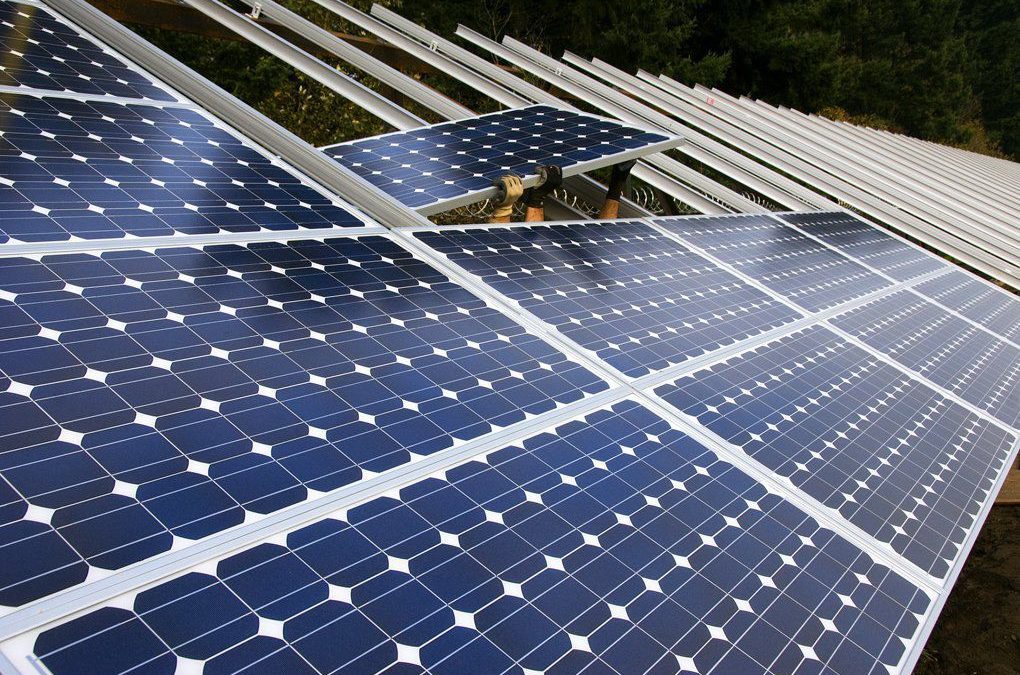
by Michael Vickerman | Mar 16, 2021 | Policy, PSC Priorities, Public Service Commission, RENEW Wisconsin, Renewables, Solar, Utilities
After simmering on the proverbial back burner for nearly two years, the third-party financing issue relating to customer-sited solar power has been thrust back into the public spotlight as pressure builds to resolve the legal questions surrounding it.
The reemergence of this issue can be traced to two parallel developments. The first is a Public Service Commission (PSC) proceeding moving toward a ruling settling the legality of third-party-owned solar systems serving individual retail customers. The second is a lawsuit recently filed by the Midwest Renewable Energy Association in Portage County Circuit Court, challenging the PSC’s authority to regulate the financing of behind-the-meter systems that serve host customers only.
The PSC proceeding began in March 2019 when Eagle Point Solar, a Dubuque-based solar contractor, filed a complaint against We Energies for blocking the installation of rooftop arrays serving the City of Milwaukee. In its complaint, Eagle Point contends that PSC Chapter 119, which regulates the interaction between small-scale electricity producers and the utility grid, does not give We Energies the right to deny interconnection to a customer based on how the generating equipment is financed. According to We Energies, however, a third party owner of the equipment that supplies electricity to one customer under contract should be regulated as a public utility.
Following an extended period of legal maneuvering, the PSC set in motion a process for investigating Eagle Point’s complaint (Docket 9300-DR-104). In so doing, it expanded the scope of the proceeding to consider the public utility question that led to the interconnection denial. When the parties finished entering evidence into the hearing record, the PSC opened a public comment window on the proceeding, which ended on February 23rd.
Supporters of third-party financing sprang into action, led by RENEW. To illustrate the breadth and depth of support for opening up the solar market in this fashion, RENEW circulated an action alert encouraging those who care about this issue to submit comments supporting Eagle Point’s position. Networks such as Wisconsin Climate Table, Wisconsin Health Practitioners for Climate Action, and our own solar contractor e-mail list helped circulate RENEW’s alert beyond our own activist base. At the same time, organizations such as 350 Madison and Environmental Law and Policy Center (ELPC) asked their activists and members to post comments on the PSC website.
As a result of our combined efforts, a total of 336 individuals and organizations weighed with their views on the Eagle Point matter. Of that, 327 comments expressed support for opening the market to allow third-party ownership of solar electric systems in Wisconsin. In that overwhelming display of support, several themes prevailed, including the following:
- Third-party financing is already expressly authorized in 28 states;
- Allowing third-party-owned solar systems is consistent with Wisconsin case law;
- The threat of being regulated as a public utility discourages businesses from providing solar power generated onsite to retail customers through leases and sale agreements;
- Third-party financing would make solar power affordable to low-to-moderate income households and nonprofit entities such as schools;
- Expanding solar financing options would help communities reduce their reliance on harmful fossil energy sources; and
- Expanding solar financing options would invigorate local economies.
These arguments track closely to those articulated by Wisconsin solar contractors and consultants in a March 2019 filing urging the Commission to approve Eagle Point’s petition. Similar to our efforts during the comment period, RENEW shaped the themes in that statement and pulled together a coalition of market actors to demonstrate support for third-party financed solar energy. In the intervening two years, Eagle Point Solar and the City of Milwaukee labored to amass a set of facts and legal arguments to support a finding that WEPCO’s action was unlawful.
The merits of this case are clear-cut, as are the regulatory remedies. Other states that regulate electric utilities have taken steps to affirm the legality of third-party-financed solar, most notably Iowa, which did so in 2014, the result of a long and expensive legal fight waged by Eagle Point. In contrast to Iowa, the State of Wisconsin has allowed this issue to languish for many years without resolution.
But with the filing of briefs from parties on March 10th, the Eagle Point proceeding has finally reached the home stretch. The strong outpouring of public support for third-party financed solar tells us that a policy call from the PSC is long overdue.
In a brief representing RENEW and other solar advocates, we urged the PSC to take the following actions:
- Order WEPCO to interconnect the City of Milwaukee solar projects, regardless of how those projects are financed;
- Clarify that a utility may not deny interconnection based on project ownership, and
- Clarify that third-party owners of customer-sited distributed generation are not “public utilities” under Wisconsin law.
RENEW would like to thank Eagle Point Solar and the City of Milwaukee for leading this crucially important regulatory battle, ELPC for drafting a particularly persuasive legal brief on behalf of clean energy advocates, and the 327 commenters who affirmed their desire for an expanded solar marketplace free of utility interference.
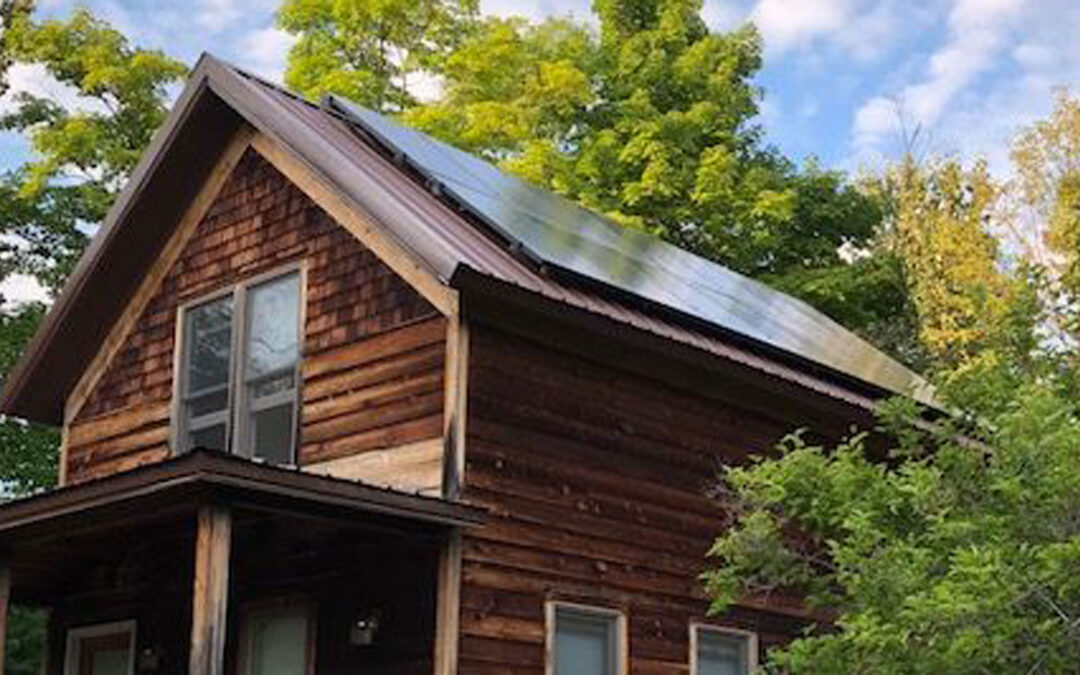
by Heather Allen | Jan 28, 2021 | Advocacy, Community, Policy, PSC Priorities, Public Service Commission, RENEW Wisconsin, Renewables, Solar
COAUTHORS: Michael Vickerman and Lauren Reeg
Wisconsin’s distributed generation (DG) renewable energy market lags behind comparable states.[1] As seen in other states, DG helps diverse groups of individuals and organizations, including businesses, residents, renewable energy customers, and future renewable energy customers, gain access to renewable energy and create a more fair and navigable market.
Whether it takes the form of behind-the-meter generators powering individual customers or larger projects feeding power directly into the distribution grid, DG is a vitally important segment of the renewable energy landscape. Customer investments drive these installations with benefits extending to Wisconsin businesses, residences, governments, nonprofits, and their communities. DG clean energy investments help spur local economic investment, support clean energy jobs, and save Wisconsin money that otherwise would have been spent on importing fossil fuels.
It has long been RENEW’s view that a more fair, clear, and consistent regulatory environment could strengthen the DG market and accelerate the transition to renewable energy in Wisconsin.
In June 2020 the Public Service Commission of Wisconsin (PSC) convened an investigative docket” (5-EI-157) to identify regulatory barriers that effectively put a tight lid on Wisconsin’s DG market, especially customer-sited DG.
This investigation is structured to encourage input and recommendations from organizations and entities that support small-scale DG. RENEW has assembled an expert legal and technical team for this docket—Tim Lindl and Melissa Birchard of Keyes and Fox, and Justin Barnes of EQ Research. We invite you to review the legal and policy analysis we provided to the PSC in August 2020 and in January 2021.[2] A coalition of organizations (Clean Energy Advocates) joined our comments to the PSC, demonstrating broad support for an improved DG market. This ongoing investigation is the best opportunity we’ve had in more than 10 years to advance renewably powered DG before the PSC.
The success of this campaign will strengthen and expand the renewable DG market in Wisconsin. If you support this work, please consider a donation to RENEW today. Together we can champion renewable energy growth in Wisconsin and we are poised to make significant progress in 2021. Join us today!
Wisconsin has fewer net metering customers than comparable states
Net metering customers represent an important segment of the renewable energy market, however, Wisconsin is falling behind. In the last four years, net metered customers in Wisconsin have grown by only 0.11%, well below the increases seen elsewhere in other states since 2015.
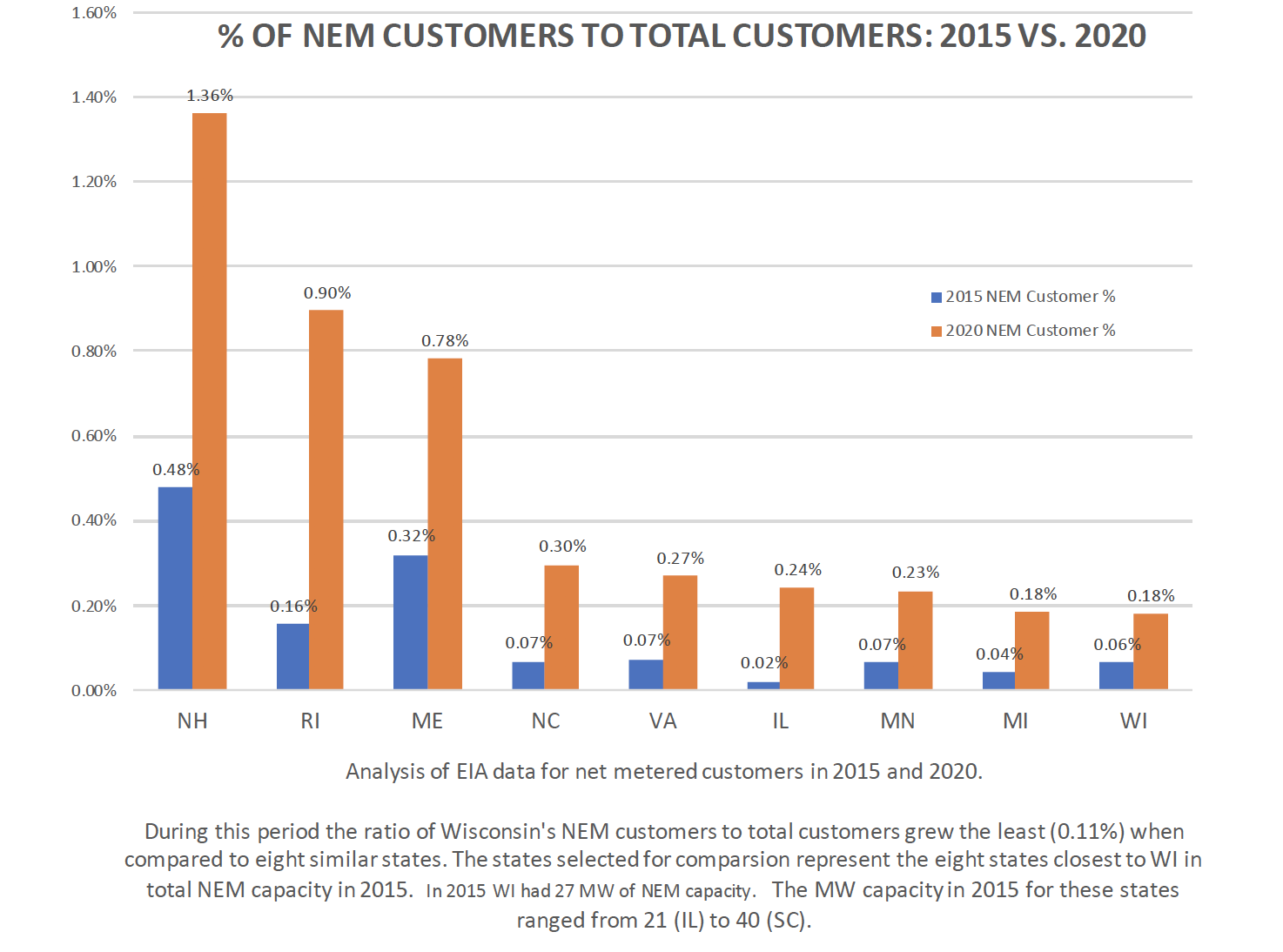
Fair and clear distributed generation policies would grow the renewable energy market in Wisconsin
RENEW Wisconsin aims to enlarge the market share for non-utility-owned renewable DG, including both self-supply and grid-supply projects. In furtherance of that goal, we’ve developed a number of principles that should inform decisions rendered in the DG docket. These include:
- Ensuring developer access to standard offer contracts that have terms for reasonable compensation.
- Giving developers insight into system and utility resource needs to help them target their planned investments.
- Provide larger energy users with better and less restrictive opportunities for larger self-supply resources.
- Standardize and improve net metering rates for all customers across Investor-owned Utilities (IOUs).
In addition to behind-the-meter systems, RENEW has also set forth a path for front-of-meter renewable generation projects up to 20MW. These types of projects should be eligible for 20-year standard offer contracts that are pegged to the same methodologies that utilities use when assigning value to their own generation projects. Leveling the playing field for compensating solar is essential to increasing customer investment opportunities, and expanding the solar workforce.
RENEW is optimistic that by the end of the docket the PSC will land on several beneficial policy changes for promoting renewable DG. These policy changes could be taken up later this year through the anticipated utility rate case filings. Should events unfold along these lines, solar developers and customers stand ready to benefit from a more fair, clear, and consistent renewable energy market.
Join RENEW’s campaign to advance renewable distributed generation in Wisconsin
Since 1991, RENEW has been the state’s preeminent advocate for renewable energy. At the macro scale, solar and wind can outcompete fossil fuels on cost and environmental performance. For the first time in more than a decade, we have an opportunity in Wisconsin to broaden the clean energy transition underway to benefit all customers who place a value in a healthy energy economy. A clear, fair and forward-looking regulatory environment will be crucial to spreading renewable energy across all sectors of society. RENEW is bringing together the leadership and expertise necessary to undo the regulatory barriers that have held renewable DG back, and to replace them with policies to make renewable DG more accessible, affordable, and plentiful across Wisconsin. We hope you will join us in this work by donating today. 2021 promises to be an exciting year!
[1] RENEW evaluated eight states closest to Wisconsin in terms of cumulative Net Energy Metering (NEM) capacity at the end of 2015, i.e., the four states immediately above and below Wisconsin in EIA data listing NEM capacity by state. The eight states closest to WI in NEM capacity in 2015 included NH, RI, ME, NC, VA, IL, MN, and MI. The 2020 data is based on NEM capacity through April 2020. The percentage of total customers uses 2018 total state customer counts for both calculations. Note that Wisconsin has fallen behind states it had previously led. See bar graph for more information.
[2] In the most recent comments filed by Clean Energy Advocates, we looked at this year’s PSC calendar to assess how our recommended actions can make their way into regulatory policy. The DG docket now underway is well-timed in that we expect every Class A investor-owned utility in Wisconsin to file for new rates in 2021.

by Michael Vickerman | Oct 7, 2020 | Focus on Energy, PSC Priorities, Public Service Commission
Now entering its 20th year of operation, Wisconsin’s Focus on Energy program is widely recognized as a model public benefits program delivering energy savings to utility customers. This statewide program, funded entirely through utility bills, provides incentives and other services to help households, businesses, and nonprofits invest in energy efficiency measures and supply themselves with clean energy.
Take Capital Brewery as an example. With financial support from Focus on Energy, the Middleton brewery and beer garden installed in 2014 a high efficiency heat recovery system with controls and a 13 kilowatt (kW) solar electric system on its roof. Thanks to these investments, Capital Brewery saves more than $4,500 each year on its heating and electricity bills.
Capital Brewing’s Wisconsin peers are also capturing the energy value of sunshine. Breweries such as Central Waters, Ale Asylum, New Glarus, Bare Bones, and Lakefront have parlayed incentives from Focus on Energy into investments in onsite solar power. In so doing, they demonstrate that incorporating sustainability and carbon reduction into their operations is good business and can often be a competitive advantage.
According to its web site, Focus on Energy has enabled millions of ratepayers to save $730 million in avoided energy costs since the program’s inception. Moreover, it has been a consistently powerful economic engine for the state of Wisconsin, yielding between $4 and $5 in economic and avoided pollution benefits for every $1 spent by the program.
But to fully appreciate Focus on Energy’s reach and impact, it’s worth reading through the dozens of energy efficiency and clean energy success stories made possible by program incentives. As these testimonials and case studies make clear, Focus offerings have something of value for every electric customer in Wisconsin, no matter how large or small they may be.
On the renewable energy side, virtually every solar photovoltaic (PV) system powering Wisconsin residences and small businesses today received a rebate from this unique, ratepayer-funded program. Nowadays, with solar installation prices down to about a quarter of where they were 10 years ago, Focus on Energy can award rebates to many more customers than in the past. Notwithstanding the ongoing pandemic, 2020 is shaping up to be a record-breaking year in the residential solar market, fueled by $2.3 million in incentives from Focus on Energy.
The popularity of its solar incentives is putting a strain on Focus on Energy’s budget going into 2021. Under its current four-year plan, the program reserves $5.5 million each year for all qualifying renewable energy investments, out of an annual budget overall of about $95 million. Increasing its overall budget would require approval from state legislators. Absent such action, Focus on Energy has little choice but to pare residential rebate levels down to $500 per installation going forward.
Electric providers throughout Wisconsin contribute 1.2% of their gross revenues into Focus on Energy. Though they are not required to participate, all of the municipal utilities and nearly half of the electric cooperatives in Wisconsin also fund the program, to the tune of $8 a year per meter.
As the overseer of Focus on Energy, the Public Service Commission (PSC) is very mindful of the demands placed on the program, and its crucial contribution to reducing fossil energy consumption and greenhouse gas emissions. To that end, PSC Chair Rebecca Valcq is asking Governor Evers to put an additional $100 million into the program, starting in July 2021. According to the PSC, the increase would cost residential households less than a $1/month.
“These programs reduce emissions,” Valcq said. “They reduce the need to go out and look at building generation and transmission projects. These programs create jobs.”
Signed into law by Governor Tommy Thompson back in 1999, Focus on Energy has enjoyed strong bipartisan support throughout its history. Considering how broadly its benefits have been spread throughout the state, increasing the program’s budget should be something both Republicans and Democrats can agree on.
Michael Vickerman is policy director of RENEW Wisconsin







